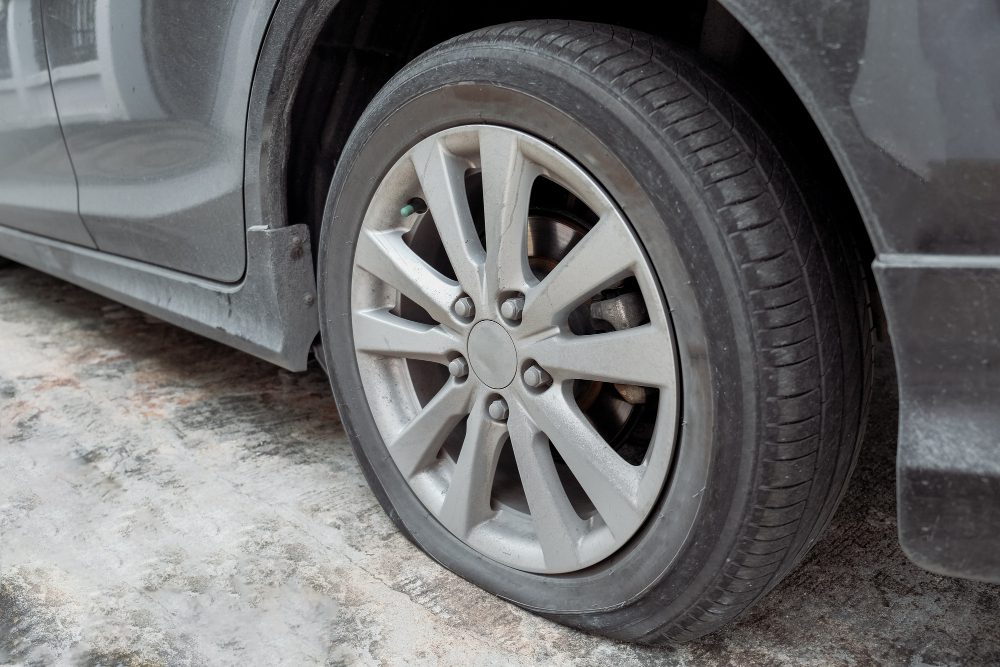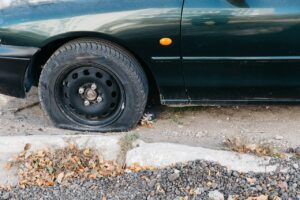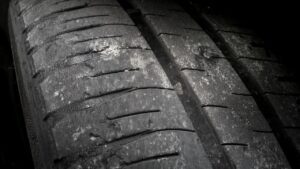That loud thump and flapping sound that follows is an unsettling noise that confirms you have a flat tire. It happens unexpectedly and in that situation, are you someone who’ll continue to drive or someone who pulls over on the side of the road immediately? At Top Dogz Towing Company in Charlotte, NC, we understand the stress and uncertainty that comes with a flat tire, and we’re here to help you make the right decision.
In this article, we’ll explore the risks and precautions to consider when dealing with a flat tire on the road. We’ll discuss what happens when you drive on a flat, how far you can safely go, and what factors affect your ability to keep driving. We’ll also provide tips on what to do if you must drive on a flat, and when it’s best to call for professional assistance. If you find yourself in need of roadside assistance in Charlotte NC, remember that Top Dogz Towing Company is just a phone call away at (704) 774-8669.
What Happens When You Drive on a Flat Tire?
Driving on a flat tire is like trying to walk with a sprained ankle – it’s possible, but it’s not a good idea. When you continue to drive on a flat, you’ll notice that your vehicle becomes harder to control. Steering feels heavy, and your car might pull to one side. This is because the flat tire can’t maintain the same level of traction as a properly inflated tire, making it harder to maneuver your vehicle safely.
Moreover, driving on a flat tire can cause severe damage to your wheel, rim, and tire. The longer you drive on a flat, the more likely it is that the tire will shred, potentially causing the wheel to grind against the road. This can lead to costly repairs and even render your vehicle undrivable. In extreme cases, driving on a flat tire can cause you to lose control of your vehicle, resulting in a dangerous accident.
Is It Ever Safe to Drive on a Flat Tire?
As a general rule, it’s best to avoid driving on a flat tire. However, there are some exceptions. If you’re in a sticky situation and need to get to a safe location, driving a short distance at a slow speed might be your only option. For example, if you get a flat tire on a busy highway with no shoulder, you may need to drive slowly to the nearest exit or rest area. But how far can you drive on a flat tire? Well, that depends on a few factors.
Factors Affecting the Distance You Can Drive on a Flat
1. Tire Type
The distance you can safely drive on a flat tire varies depending on several factors. One of the most significant factors is the type of tire you have. If your vehicle is equipped with run-flat tires, you might be able to drive for 50 miles or more at a reduced speed. Run-flat tires are designed to maintain their shape and support the weight of your vehicle even when they’re punctured, allowing you to keep driving until you can safely change the tire.
However, if you have standard tires, you’re looking at a much shorter distance. In most cases, it’s not recommended to drive more than a few hundred yards on a standard flat tire. The further you drive, the more damage you’ll cause to your tire and wheel.
2. Vehicle Type and Weight
Another factor to consider is your vehicle type and weight. Heavier vehicles, such as large SUVs and trucks, put more stress on their tires than lighter vehicles like compact cars. This means that driving on a flat tire in a heavy vehicle is riskier and can cause more damage.
3. Driving Speed and Road Conditions
Driving speed and road conditions also play a role in how far you can drive on a flat. The faster you drive and the rougher the road, the more stress you’ll put on your damaged tire and wheel. Potholes, debris, and uneven surfaces can cause further damage and make it harder to control your vehicle.
4. Extent of Tire Damage
Finally, the extent of the damage to your tire will affect how far you can drive. A small puncture might allow you to limp along for a short distance, but a large tear or blowout means you should stop immediately to avoid causing more damage or losing control of your vehicle.
Precautions to Take If You Must Drive on a Flat Tire
If you find yourself in a situation where you have to drive on a flat, it’s essential to take certain precautions to minimize the risk of damage and accidents.
- First and foremost, slow down and avoid sudden movements. Driving at a reduced speed will help you maintain control of your vehicle and reduce the stress on your damaged tire.
- Next, turn on your hazard lights to warn other drivers that you’re experiencing a problem. This will help them give you extra space and avoid any sudden maneuvers that could cause an accident.
- It’s also crucial to keep plenty of space between you and other vehicles. Driving on a flat tire makes it harder to stop and maneuver, so you’ll need extra room to react to any changes in traffic or road conditions.
- Finally, find a safe place to pull over as soon as you can. The longer you drive on a flat tire, the more damage you’ll cause to your vehicle and the greater the risk of an accident. Look for a flat, stable surface away from traffic where you can safely change your tire or wait for assistance.
When to Call for Professional Assistance
If you’re unsure about driving on a flat or don’t feel comfortable changing your tire, it’s always best to call for help. Attempting to change a tire on the side of a busy road can be dangerous, especially if you’re not experienced or don’t have the right tools.
At Top Dogz Towing Company, we offer mobile flat tire repair services in Charlotte, NC. We’ll come to you, fix your flat, and get you back on the road safely.
Preventive Measures to Avoid Flat Tires
Of course, the best way to deal with a flat tire is to avoid getting one in the first place. While some flats are unavoidable, there are several preventive measures you can take to reduce your risk.
First, make sure to check your tire pressure and tread depth regularly. Underinflated tires are more susceptible to punctures and blowouts, while worn-out tires provide less traction and are more likely to fail. Check your tire pressure at least once a month and before any long trips, and replace your tires when the tread depth reaches 2/32 of an inch.
Second, be mindful of road hazards like potholes, debris, and curbs. Hitting a pothole or running over sharp debris can cause instant tire damage, while repeatedly bumping into curbs can weaken your tire sidewalls over time. Stay alert and avoid these hazards whenever possible.
Finally, consider investing in run-flat tires or keeping a spare tire in your trunk. Run-flat tires can give you peace of mind knowing that you can keep driving even if you get a puncture, while a spare tire can get you back on the road quickly if you experience a flat.
Conclusion
So, can you drive on a flat tire? While it’s possible in some cases, it’s always best to err on the side of caution. Driving on a flat can be dangerous and cause expensive damage to your vehicle. If you do get a flat, remember that Top Dogz Towing Company is here to help. Give us a call at (704) 774-8669, and we’ll take care of you. By following the precautions outlined in this article and taking steps to prevent flats in the first place, you can stay safe and avoid the stress of dealing with a flat tire on the road.




